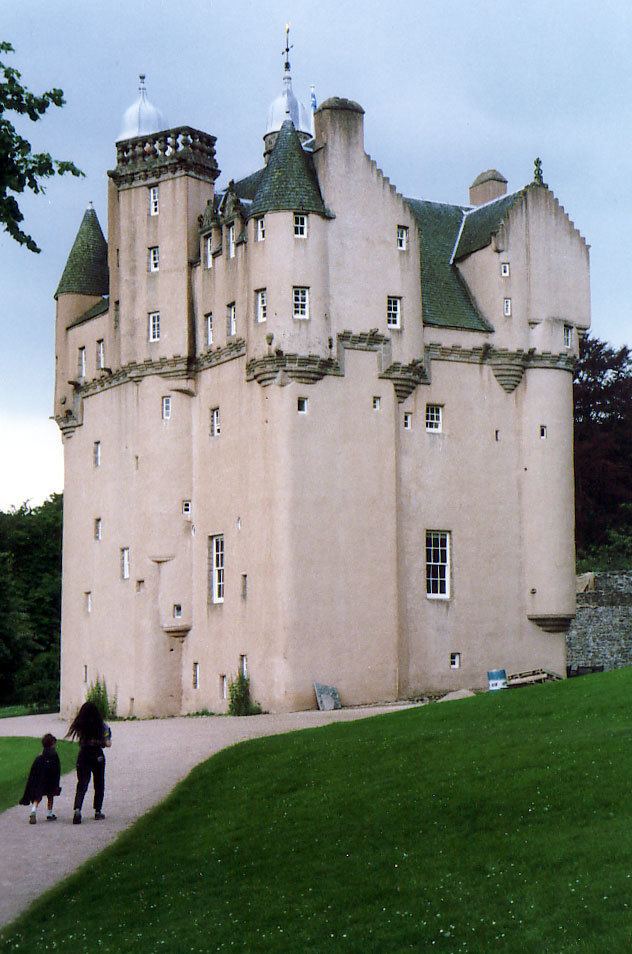Name Forbes baronets | ||
 | ||
There have been five Baronetcies created for people with the surname Forbes, four in the Baronetage of Nova Scotia and one in the Baronetage of the United Kingdom. The first holder of the Burn Baronetcy of Jessfield, created in the Baronetage of the United Kingdom in 1923, assumed the surname of Forbes-Leith of Fyvie in 1925.
Contents
- Forbes later Stuart Forbes of Monymusk 1626
- Baronets
- Forbes of Castle Forbes 1628
- Forbes of Craigievar 1630
- Forbes of Foveran 1700
- Forbes of Newe 1823
- Burn later Forbes Leith of Fyvie of Jessfield 1923
- References
Forbes, later Stuart-Forbes, of Monymusk (1626)
The Forbes Baronetcy, of Pitsligo and Monymusk in the County of Aberdeen, was created in the Baronetage of Nova Scotia on 30 March 1626 for William Forbes, with remainder to heirs male whatsoever. He was a descendant of Duncan Forbes, second son of James Forbes, 2nd Lord Forbes (see the Lord Forbes). The eighth Baronet assumed the additional surname and arms of Hepburn. He was the heir general of the last Lord Forbes of Pitsligo (his ancestor, the fourth Baronet, having married Hon. Mary, daughter of Alexander Forbes, 3rd Lord Forbes of Pitsligo). His only child, Harriet Williamina, married Charles Henry Rolle Trefusis, 20th Baron Clinton. On the Baronet’s death in 1828 the Forbes of Pitsligo estates passed to his daughter and son-in-law (see the Baron Clinton). The seventh Baronet married Williamina Wishart, only child and heiress of Sir John Belshes Wishart (later Stuart), 4th Baronet. The tenth Baronet assumed the additional surname of Stuart.
Baronets
The heir apparent is the present holder's son Kenneth Charles Stuart-Forbes, Younger of Pitsligo (born 1956).
The heir apparent's heir apparent is his only son Samuel Alexander Murray Stuart-Forbes (born 1989).
Forbes, of Castle Forbes (1628)
The Forbes Baronetcy, of Castle Forbes in the County of Longford, was created in the Baronetage of Nova Scotia on 29 September 1628 for Sir Arthur Forbes, 1st Baronet. He was the great-great-grandson of the Hon. Patrick Forbes, third son of the aforementioned James Forbes, 2nd Lord Forbes. His son, the second Baronet, was elevated to the Peerage of Ireland as Earl of Granard in 1684.
Baronets
See the Earl of Granard
Forbes, of Craigievar (1630)
The Forbes Baronetcy, of Craigievar in the County of Aberdeen, was created in the Baronetage of Nova Scotia on 20 April 1630 for William Forbes. He was also a descendant of Hon. Patrick Forbes, third son of the second Lord Forbes, and the nephew of the first Baronet of the 1628 creation. The fourth Baronet represented Aberdeenshire in the House of Commons. The fifth Baronet married the Hon. Sarah Sempill, eldest daughter of Hugh Sempill, 12th Lord Sempill. Their grandson, the eighth Baronet, succeeded as seventeenth Lord Sempill in 1884 (see Lord Sempill for earlier history of this title). The titles remained united until the death of his grandson, the nineteenth Lord and tenth Baronet, in 1965.
Here great controversy arose. As he only had female issue, the baronetcy and the barony had to be separated. He was succeeded in the lordship by his daughter (see Lord Sempill for later history of this title) while the baronetcy had to pass to his male successor. His youngest sister, Elizabeth Forbes-Sempill had changed his legal gender by petitioning the Sheriff of Aberdeen in 1952, becoming Ewan Forbes-Sempill; as a result, after a two-year legal dispute, the title passed to the younger sibling of the tenth baronet. On the death of Sir Ewan in 1991, the title was then inherited by the cousin who had challenged the legality of the succession, and he became Sir John Alexander Cumnock Forbes-Sempill, Bt.
Baronets
Forbes, of Foveran (1700)
The Forbes Baronetcy, of Foveran, was created in the Baronetage of Nova Scotia on 10 April 1700 for Samuel Forbes. The title became dormant on the death of the third Baronet in circa 1760.
Baronets
Forbes, of Newe (1823)
The Forbes Baronetcy, of Newe in the County of Aberdeen, was created in the Baronetage of the United Kingdom on 4 November 1823 for Charles Forbes, a merchant in Bombay, India. In 1833 he became the heir male of Alexander Forbes, 3rd Lord Forbes of Pitsligo (a title which had been attainted in 1745), and was allowed by the Lord Lyon to use the Pitsligo arms and supporters. Forbes was a descendant of William Forbes, younger brother of Sir Alexander Forbes of Pitsligo (from whom the Lords Forbes of Pitsligo descended) and great-grandson of Sir William Forbes, brother of Alexander Forbes, 1st Lord Forbes.
Baronets
Burn, later Forbes-Leith of Fyvie, of Jessfield (1923)
The Forbes-Leith of Fyvie Baronetcy, of Jessfield in the County of Midlothian, originally the Burn Baronetcy, was created in the Baronetage of the United Kingdom on 7 March 1923 for the soldier and Conservative politician Charles Rosdew Burn. He had previously represented Torquay in the House of Commons. Burn was the youngest son of General Robert Burn and the husband of Hon. Ethel, only daughter and heiress of Alexander John Forbes-Leith, 1st Baron Leith of Fyvie. By edict of the Lord Lyon in 1925 Burn assumed the surname and arms of Forbes-Leith of Fyvie, for himself, his wife and son, according to the terms of his father-in-law’s will. Lord Leith of Fyvie was the eldest son of Rear-Admiral John James Leith by his wife Margaret, daughter and heir of Alexander Forbes, a descendant of Duncan Forbes, second son of the second Lord Forbes. The first Baronet's younger son, the second Baronet, served as Lord Lieutenant of Aberdeenshire from 1959 to 1973.
Baronets
The heir apparent is the present holder's only son Alexander Philip George Forbes-Leith (born 1999).
